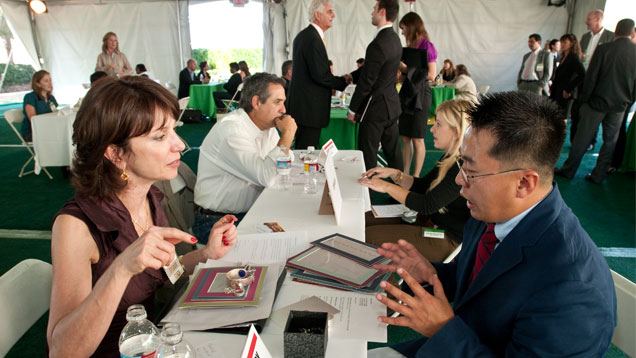Career Fair Bridges Gap Between Grads, Employers
September 17, 2013

The following is excerpted from “Legacy of Leadership: A History of the Gemological Institute of America” (2003).
Back in early 1991, Kathryn Kimmel [then GIA director of Marketing] faced an altogether different type of challenge, one that went beyond branding or advertising and marketing campaigns. Her industry contacts and extensive retail and jewelry manufacturing experience were in demand throughout the Institute in more ways than she had anticipated. Kimmel recalled, “I had a steady stream of students passing through my office who had completed their education at GIA and were ready to move out into the world, but were looking for guidance on how to do it.”
Kimmel was dedicated to helping these students, but at most she could mentor only a few each year. There were hundreds more, many of them starting second careers, who needed assistance. While GIA maintained a listing of job opportunities, it had no formal program to facilitate networking between students and the trade. Something needed to be done.
Kimmel knew from her experience in the trade that there was a huge demand for new talent. Now she could see firsthand that the talent was available—the problem was how to bring demand and supply together. She proposed a solution to [then president, Bill] Boyajian: a GIA-hosted “career fair” that would bring GIA students together with industry figures, both to teach the students more about searching for a job and to introduce them to the trade. Boyajian backed the idea, and Kimmel got to work.
The first place Kimmel went was the 24 Karat Club of Southern California, where she had been a board member for six years. She pitched the idea to her longtime friend Howard Sherwood. Sherwood immediately agreed to be her co-chair, but others were not as convinced. “Some of them told me it was impossible,” Kimmel said. “I responded, ‘Just watch!’”
Throughout that summer of 1991, Kimmel worked with a steering committee assembled from members of the 24 Karat Club, among them the club’s president, Jack Zemer; Bart Boydston and Earl Lynch of the Diamond Promotion Service; Lynn Diamond of National Jeweler; and Matt Runci of the Manufacturing Jewelers & Silversmiths of America. The committee set out to build support, financial and otherwise, for a GIA Career Fair. One by one, the doubters were won over, and momentum grew rapidly.
The first Career Fair was held at GIA’s Santa Monica campus in October 1991, in conjunction with the 24 Karat Club of Southern California’s annual dinner dance. Two hundred and fifty students attended a series of panel discussions on job opportunities in the gem and jewelry industry, the various fields within the trade, and how to move from the classroom to a full-time job. In addition, 23 companies came to recruit.
The embedded asset does not exist:
Asset Type: GIA_Image
Asset Id: 1355961082473
PAGENAME: GIA/GIA_Image/EmbedImageOnly
Asset Type: GIA_Image
Asset Id: 1355961082473
PAGENAME: GIA/GIA_Image/EmbedImageOnly
Left: Kathryn Kimmel, co-founder of Career Fair, speaks during a panel. Right: A recruiter meets with a job seeker at GIA Career Fair in Carlsbad.
Industry response was enthusiastic. When the second Career Fair was held in 1992, something new became its most successful feature: one-on-one guidance from industry leaders on how to find openings and prepare resumés, and to hear about trade opportunities firsthand. “We had a lot of smart students who had little experience in preparing a resumé,” Kimmel said.
In January 1993, GIA New York inaugurated its own Career Fair. Kimmel believed that Career Fair could do far more than recruit GIA students for industry jobs—it could also attract talented people to the industry. It was a promise that was realized more fully than Kimmel anticipated.
For the Zale Corp., then the largest U.S. jewelry retailer, Career Fair was “our premier recruitment event,” said Susan Goodfellow, the company’s staffing manager, in 1998. “We [come] looking for regional managers, store managers, and sales associates nationwide. We [hire] jewelry professionals at all levels of expertise, including buyers and store operations personnel.”
By 2002, the Career Fair in New York was attracting more than 1,000 people, while Carlsbad drew more than 800. With the success of GIA’s Career Fair on both coasts, the trade had come to view it as one of the most important services provided by the Institute, not in the least because it was the largest formal recruiting opportunity in the industry. A modest gathering held before the 24 Karat Club’s annual dinner had grown into a major industry event where GIA students and jobseekers from outside the industry were able to rub elbows with executives from major jewelry companies.
“Career Fair has done more than just find jobs and mentors for thousands of students,” Kimmel said. “It attracted a lot of new talent to the industry, and it allowed industry figures to give back. When people come up to me and say, ‘I went to Career Fair eight years ago, and I didn’t know a thing, and now I’m vice president of a major jewelry company,’ that’s when I know it really paid off. It’s truly the last bridge from GIA to the trade, and from the trade to our students.”
The embedded asset does not exist:
Asset Type: GIA_Image
Asset Id: 1355961082541
PAGENAME: GIA/GIA_Image/EmbedImageOnly
The embedded asset does not exist:
Asset Type: GIA_Image
Asset Id: 1355961082541
PAGENAME: GIA/GIA_Image/EmbedImageOnly
A Carlsbad Career Fair attendee meets with designer Paul Klecka for an informal coaching session.



